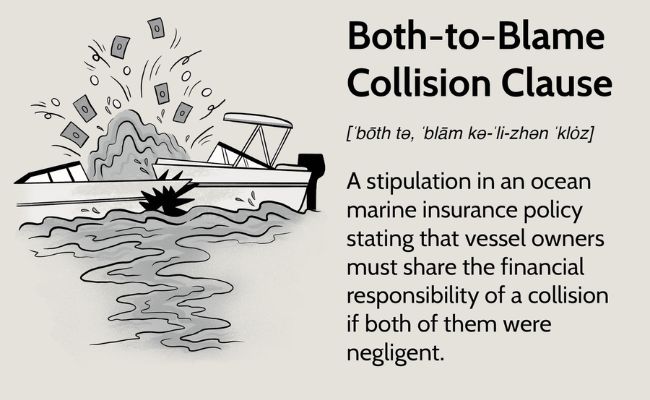Both to Blame Collision Clause is appearing in the Clause 3 of Institute Cargo Clauses which provides that “This insurance is extended to indemnify the Assured against such proportion of liability under the contract of affreightment “Both to Blame Collision” Clause as is in respect of a loss recoverable hereunder. In the event of any claim by shipowners under the said Clause the Assured agree to notify the Underwriters who shall have the right, at their own cost and expense, to defend the Assured against such claim. The “Both to Blame collision” clause was first known as “Toluma” clause because it was introduced following a case in 1935 involving a vessel called “Toluma”.
Under this clause, the assured agrees to notify the underwriters who shall have the right at their cost and expenses to defend the assured against such claims to pay contribution demanded by ship-owners in the event of a claim.
Example
Where two vessels collide with each other, the maritime law of various countries provides that liability for damages to each other shall be fixed according to the degree of negligence say 60: 40. Since the conditions of bills of lading excuse the ship-owners from the consequences of the negligence of his servants, cargo owners of the carrying vessel are not entitled to recover their compensation from the carrying vessel in the event of a collision with the non carrying vessel according to the one of the conditions of bills of lading. In this situation, they have to approach non-carrying vessel to recover only a portion of their loss corresponding to the degree of blame attaching to the non-carrying vessel.
Adjustment of claim
Vessel “A” or “B” were in collision. “A” was adjudged 75% to Blame and “B” 25%. The respective claims are as under
| Particulars | “A” | “B” |
| Damage to vessel | Rs 3,00,000.00 | Rs 2,40,000.00 |
| Damage to cargo | Rs 30,000.00 | Rs 60,000.00 |
| Rs 3,30,000.00 | Rs 3,00,000.00 |
| Particulars | Particular Average | Collision | P& I |
| Damage to vessel “A” | Rs 3,00,000,00 | ||
| Damage to Cargo “A” | No liability | ||
| Damage of “B” ( 75% of Rs 3,00,000.00)
Rs 2,25,000.00 and 3/4th of this Rs 1,68,750.00 1/4th Rs 56,250.00 |
Rs 1,68,750.00 | Rs 56,250.00 | |
| Recovery from “B” 25% of Rs 3,00,000.00 | Rs 75,000.00
( Cr from “B”) |
Rs 1,68,750.00 | |
Claim under Hull and Machinery policy “A”
| Particular Average | Rs 2,25,000.00 |
| Collision Liability | Rs 1,68,750.00 |
| Rs 3,93,750.00 | |
| Deductible | Rs 30,000.00 |
| Total liability | Rs 3,63,750.00 |
According to United States law, (and this law would be applied to ships of any nationality if the action was in the USA), the position is not the same. Liability of the non- carrying vessel is not limited corresponding to the degree of blame attaching to the non-carrying vessel.
Irrespective of the degree of blame, which may be differing degrees, the measure of liability is determined as if both vessels were equally to blame and the cargo of each carrying vessel can recover its full damages from the other vessel despite the fact that the non-carrying vessel was only partly to blame for the collision giving rise to the damage.
The non-carrying vessel which pays the cargo damages in full may recover one half (50%) from the carrying vessel, in the settlement between ship and ship. It will, therefore, be seen that the carrying vessel is debited with 50% of its own cargo damage although the conditions of the B/L will prevent the cargo interest to recover the amount of loss direct from the carrying vessel.
The Hull insurers of the carrying vessel are not liable for this amount as a collision liability and this amount is not recoverable from the P& I club also in which the vessel is entered.
As such, the shipowners of the carrying vessel claim an indemnity from the cargo owner who has recovered his damage in full from the non-carrying vessel, which in turn recovers 50% from the carrying ship.
Considering the law of the United States one could, therefore, appreciate the significance of the Both to Blame Collision Clause.


